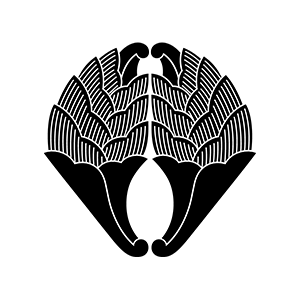Saga Domain (2/2)One of the leading figures of the Meiji Restoration

Nabeshima family crest “Apricot leaf crest”
- Article category
- History of the domain
- domain name
- Saga Domain (1607-1871)
- Affiliation
- Saga Prefecture
- Related castles

Saga Castle
- related castles
Under such circumstances, Nabeshima Naomasa, who assumed the position of the 10th lord of the domain, reduced expenditures by reducing the number of government officials to one-fifth, and reformed the domain's finances by focusing on the development and trade of industries such as porcelain, tea, and coal. By doing so, he succeeded in reforming the feudal government.
Furthermore, with the aim of strengthening Nagasaki's security, they independently introduced Western military technology, installed smelting methods, and focused on acquiring science and technology such as reverberatory furnaces.
As a result, the Saga Domain succeeded in producing state-of-the-art Western-style cannons and guns, including the Armstrong Gun. Mietsu Naval Dock was established as a base for steamships and Western-style sailing ships, and steam engines and a steamship called the Muiryofuumaru were also completed.
This technology was of great help in the construction of Shinagawa Daiba, and gained the trust of Masahiro Abe, the elder statesman of the Edo shogunate.
Around the same time, in 1853, Matthew Perry arrived and pressed for the opening of the country, but Nabeshima Naomasa
He advocated opening up the country in contrast to British goodwill diplomacy.
After Nabeshima Naomasa handed over the lordship to his eldest son, Nabeshima Naohiro, he met with Kanpaku Tadahiro Konoe and requested that he be appointed to the post of Kyoto shugo.
After the death of his ally Masahiro Abe, he distanced himself evenly from the Sabaku, Sonno, and Kobu Gattai factions to prevent casualties within the domain.
With the Saga clan in this position, during the Battle of Toba and Fushimi, the Satsuma clan called for the conquest of Saga, but the Saga clan skillfully maneuvered around and the Satsuma and Choshu clans achieved victory. After the war ended, he moved to Tokyo and joined the new government, so no conquests were carried out.
Furthermore, the modern Western weapons of the Saga Domain became the main force of the new government's army from the battle with Ueno Shogitai to the Battle of Goryokaku, and supported the establishment of the Meiji government.
In this way, due to the domain administration conducted by Nabeshima Naomasa, the Saga domain succeeded in modernizing quickly among other domains, and many human resources were also developed. For this reason, they were less enthusiastic about the anti-shogunate movement than the Satsuma and Choshu domains.
Despite this, the Saga domain ended up taking charge of a part of Satsumacho Toi.
In 1869, after the abolition of feudal domains and the establishment of prefectures, Nabeshima Naomasa was appointed as the governor-general of Ezo. Naomasa himself did not go to Ezo, but ordered former feudal retainers such as Yoshiyu Shima to develop the area, and actively had retainers from the Saga domain also migrate to Ezo.
Naomasa himself was transferred to the position of Dainagon, where he proposed the development of Manchuria and the development of mines in Australia.
When Nabeshima Naomasa died of illness in 1871, the influence of the Saga domain (Hizen) rapidly declined within the Satsuma-cho Toi dynasty.
Nabeshima Naomasa's achievements were so great that he is counted as one of the Seven Sages of Saga, along with Yoshiyu Shima, Tsunetami Sano, Taneomi Soejima, Takato Oki, Shinpei Eto, and Shigenobu Okuma.
After the Meiji Restoration, Nabeshima Naohiro, the eldest son of Nabeshima Naomasa and the last lord of the domain, became the governor of the Saga domain, but he resigned and went to study in the United States as part of the Iwakura mission, and after returning to Japan, he was given the reins by his younger brother Naohiro. I will study abroad in England with Tora Naoju. After returning to Japan, he became an official at the Ministry of Foreign Affairs, and in 1880 was appointed Minister Extraordinary and Plenipotentiary to the Kingdom of Italy.
He returned to Japan in 1882 and served as a member of the Senate and an advisor to the imperial court, gaining the deep trust of Emperor Meiji and Emperor Taisho.
Afterwards, he devoted himself to the modernization of Japan, including the operation of the Rokumeikan and Ueno Shinobazu Pond racetracks, the development of foreign settlements and summer resorts, the construction of railways, and the promotion of music.
Current Nabeshima family
The bloodline of the Nabeshima family continues to this day, and the current head of the family is Naoaki Nabeshima, the 15th generation. Naoaki's younger sister, Fusako Nabeshima, is currently the director of Chokokan, a historical museum that handles artifacts from the Nabeshima family, the lords of the Saga domain and marquis.
Reread the article on Saga Domain
- related castles

- WriterAYAME(Writer)I am a writer who loves history, focusing on the Edo period. My hobbies are visiting historical sites, temples and shrines, and reading historical novels. If there is a place you are interested in, you can fly anywhere. I'm secretly happy that the number of sword exhibitions has increased recently thanks to the success of Touken Ranbu.



